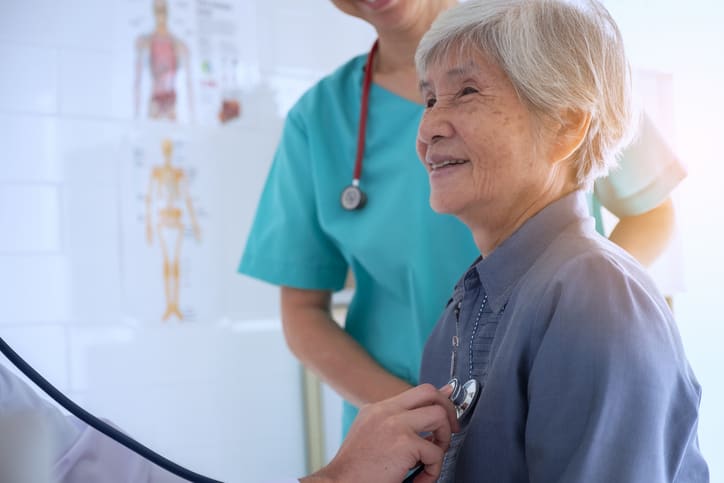[3 MIN READ]
In this article:
-
Lung cancer is the leading cause of cancer death in the United States; early detection and treatment can greatly increase survival.
-
Lung cancer screening exams are painless and non-invasive. The test takes only a few minutes.
-
A Swedish expert discusses the rising rates of lung cancer rates among people who have never smoked and why recognizing risk factors and screening for lung cancer is critical.
According to the American Lung Association, lung cancer is the leading cause of cancer death, accounting for one in five of all cancer deaths. Fortunately, when detected early, lung cancer can be very treatable. In fact, for patients whose lung cancer is found early, five-year survival is almost 56%.
While screening and early detection are critical to lung cancer survival, prevention is also key to stopping lung cancer. More than 238,000 patients are diagnosed with lung cancer every year – prevention can help lower that number in the future.
“Lung cancer remains the number 1 cause of cancer-related mortality in the United States.” Says Sid Devarakonda, M.D., director of thoracic medical oncology at the Swedish Cancer Institute. "We definitely have more effective treatment options than we did a couple of decades ago, but prevention is always better than a cure.”
Know your risk
Risk factors are things that increase your risk of developing a disease. Having risk factors for lung cancer doesn’t mean you will develop lung cancer, but they are important to know, track and share with your physician so you know if and when you should consider screening.
Risk factors for lung cancer include:
- Smoking.
- Secondhand smoke exposure.
- Family history of lung cancer.
- Increased age.
- Previous radiation exposure.
- Radon gas, asbestos and other carcinogen exposure.
While some risk factors, like a family history of the disease, can’t be changed, others can be controlled, which can help lower your risk of developing lung cancer. Stopping smoking (the leading cause of lung cancer) and limiting exposure to secondhand smoke can significantly reduce the risk of lung cancer.
“With lung cancer, it’s important to control what you can control and monitor what you cannot,” says Dr. Devarakonda. “Traditionally, we understand lung cancer as a smoker’s disease, but people who have never smoked in their life can still get lung cancer. For reasons we don’t understand yet, this appears to be more common in Asian women. That’s why it’s critical to know your risk factors and do what you can to eliminate those things that elevate your risk further.”
The importance of early screening
The goal of lung cancer screening is to catch cancer early before tumors have had a chance to spread, which is often before any symptoms develop. At this stage, lung cancer has more cancer care options available and has a better chance of being cured.
“Early detection is critical to successful treatment of lung cancer for you or a loved one,” says Dr. Devarakonda. “When found before it has started to spread, many lung cancers are very treatable, and patients can enjoy longer survival. We have a lung cancer screening program at Swedish that patients can be referred to through their primary care physician.”
Individuals who have one or more lung cancer risk factors, especially older adults who have a history of smoking, including cigarette smoking, should speak with their doctor about if and when to begin regular screening for lung cancer.
Early signs of lung cancer may include:
- Chest pain.
- Developing a new cough.
- Shortness of breath.
- Weight loss.
Lung cancer screening usually involves a low dose computed tomography (CT) scan to take pictures of the lungs. This exam is painless, non-invasive and takes only a few minutes.
“At Swedish, our goal is to implement screening programs that are accessible to patients who need them in every community we serve,” says Dr. Devarakonda. “We are working to better understand the many questions around lung cancer, including what causes it in people who have never smoked. We also want to ensure that we can provide patients with lung cancer with the latest treatments, such as the ability to map mutations or genetic changes in tumors, immunotherapy and other experimental treatments.”
Keep your lungs healthy
While early detection is crucial, preventing lung cancer is always better than a cure. The American Lung Association has these recommendations for keeping your lungs healthy:
- Quitting smoking and avoiding secondhand smoke.
- Avoiding exposure to hazardous chemicals.
- Eating healthy goods.
- Staying physically active.
- Testing your home for radon.
__
Additional resources
Nonsmokers and lung cancer: What to know| The Seattle Times
Learn more and find a provider
Our lung cancer experts at the Swedish Cancer Institute can work with you to find the right diagnostics and treatments. We don't just treat your lung cancer, we treat you. To speak with someone or make an appointment, call 1-855-XCANCER.
Do you or a family member need help quitting tobacco use? If you’re thinking about quitting, or your doctor has advised you to quit, Swedish can help. You can also learn more about developing a plan and finding support to quit at the Washington State Quitline.
Swedish Virtual Care connects you face-to-face with a nurse practitioner who can review your symptoms, provide instruction and follow up as needed. If you need to find a provider, you can use our provider directory.
Join our Patient and Family Advisory Council.
This information is not intended as a substitute for professional medical care. Always follow your health care professional’s instructions.
Follow us on Facebook, Instagram and Twitter.
About the Author
More Content by Swedish Cancer Team
























